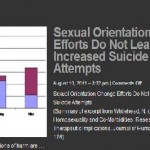Writing in the second edition of NARTH’s (National Association for the Research and Therapy of Homosexuality) Journal of Human Sexuality, Neil Whitehead proposed a reanalysis (NARTH summary here) of a paper by Ariel Shidlo and Michael Shroeder on potentially harmful outcomes of sexual orientation change efforts. NARTH’s headline describing the paper is
Sexual Orientation Change Efforts Do Not Lead to Increased Suicide Attempts.
 Contrast NARTH’s headline with the title of my post. After examining Whitehead’s article, I submit that his analysis supports my title as much or more than it does NARTH’s claim.
Contrast NARTH’s headline with the title of my post. After examining Whitehead’s article, I submit that his analysis supports my title as much or more than it does NARTH’s claim.
Shidlo and Shroeder wrote the following about suicide attempts in their 2002 report:
In examining the data, we distinguished between participants who had a history of being suicidal before conversion therapy and those who did not. Twenty-five participants had a history of suicide attempts before conversion therapy, 23 during conversion therapy, and 11 after conversion therapy. We took the subgroup of participants who reported suicide attempts and looked at suicide attempts pre-intervention, during intervention, and post-intervention to see if there was any suggestive pattern. We found that 11 participants had reported suicide attempts since the end of conversion interventions. Of these, only 3 had attempted prior to conversion therapy. Of the 11 participants, 3 had attempted during conversion therapy.
In his NARTH paper, Whitehead makes a series of assumptions about the participants in the Shidlo and Schroeder study. I think these are questionable assumptions but for sake of discussion, I will play along. First, he assumes that these suicide attempts occur over a span of 25 years (13 years pre-therapy, two years in therapy and then 10 years post-therapy). He then assumes that the attempts occurred at a constant rate over that span to calculate an expected number of suicide before, during and after therapy. Whitehead then compares his expected attempts with the actual number of attempts as reported by Shidlo and Schroeder. Whitehead summarized his findings as follows:
(a) Comparing pre-therapy, therapy, and post-therapy groups, there is overall no significant increase in suicides per unit time.
(b) There is a very clear increase in attempts during therapy.
(c) There is a trend to fewer attempts after therapy.
Using his assumptions, Whitehead wrote:
Suicide attempts reported before therapy were 25, and those reported during and after therapy combined numbered 34. The expected numbers allowing for the time periods and normalized to the above total are 30.55 and 28.44. The expectation on which this is calculated is that therapy has no effect, either positive or negative.
In this analysis, no difference shows up in suicides related to therapy when suicide attempts before therapy are compared with the time period during and after therapy. However, Whitehead does not stop there. About suicide attempts during therapy, he wrote:
For attempts before and during therapy, the observed results are 25 and 23, and the calculated expected normalized figures are 42.18 and 5.82. These are very different from the observed, and the chi-square test produces a result of p < 0.001. They are not the same, and therapy has therefore been associated with a several-fold increase in attempts.
In other words, there is a very large increase in suicide attempts during therapy. The title of my post is accurate. According to this NARTH report, sexual orientation change “therapy has therefore been associated with a several-fold increase in attempts.”
Continue reading “NARTH Report: Suicide attempts increase during sexual orientation change therapy”